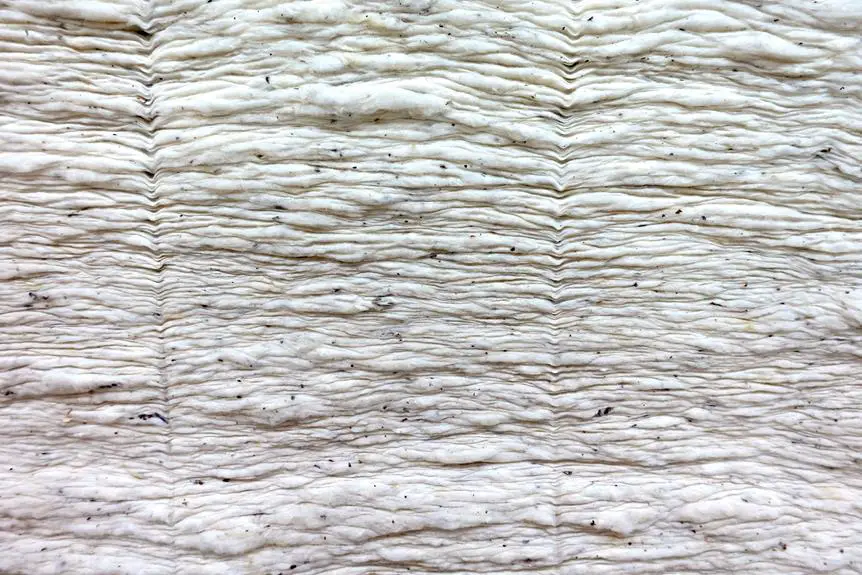Have you ever experienced the frustration of buying a cotton shirt that feels smooth in the store, only to find it rough and uncomfortable after a few washes? Understanding the true nature of cotton fabric texture can be a game-changer for your wardrobe.
In this exploration, we'll delve into the factors that contribute to the roughness or smoothness of cotton, debunk myths, and provide tips for identifying and maintaining the smoothest cotton fabrics.
Get ready to elevate your fabric mastery and make informed choices for your clothing collection.
Key Takeaways
- The quality of cotton fibers, specifically long-staple cotton, greatly influences the texture of the fabric, with lower quality cotton resulting in a rougher texture.
- The type of fabric weave, such as plain weave or twill weave, can impact the softness of the cotton fabric, with plain weave creating a smooth and soft fabric.
- The tightness of the fabric weave also affects the softness, with a looser weave typically resulting in a softer fabric.
- Longer cotton fibers contribute to a smoother yarn and create a more breathable fabric, enhancing the overall softness and comfort when wearing cotton fabric.
Understanding Cotton Fabric Texture
When you touch cotton fabric, you may notice that it feels both rough and smooth due to the natural fibers intertwining with each other. The perception of cotton fabric texture is influenced by various factors, including the quality of the cotton fibers used in the fabric.
Higher quality cotton, such as long-staple cotton, tends to create a smoother texture due to the length and strength of the fibers. On the other hand, lower quality cotton with shorter fibers may result in a rougher texture.
Cotton fabric quality plays a crucial role in determining the overall texture perception. Fabrics made from high-quality cotton are often prized for their softness and smooth feel against the skin. In contrast, lower quality cotton can yield a coarser texture that feels rougher to the touch.
Understanding the relationship between cotton fabric quality and texture perception can empower you to make informed decisions when selecting cotton-based products.
Factors Affecting Cotton Fabric Softness
When it comes to the softness of cotton fabric, several factors come into play.
The impact of fabric weave, cotton fiber length, and fabric finishing techniques all contribute to the overall feel of the fabric.
Understanding how these elements affect cotton fabric softness can help you make informed choices when selecting textiles for your clothing or home furnishings.
Fabric Weave Impact
To achieve a soft and smooth cotton fabric, the tightness and type of weave play a significant role. The impact of fabric weave on cotton fabric softness is crucial in fabric texture analysis. The weave affects how the fabric feels against the skin.
For instance, a plain weave, with its simple over-one-under-one pattern, creates a smooth and soft fabric. On the other hand, a twill weave, characterized by diagonal lines, can result in a softer fabric due to its looser construction.
Additionally, the tightness of the weave can influence the fabric's softness. A looser weave tends to create a softer feel, while a tighter weave may result in a firmer texture.
Understanding the impact of fabric weave on cotton fabric softness provides insight into selecting the most suitable fabrics for desired comfort.
Cotton Fiber Length
You might be wondering how cotton fiber length affects the softness of cotton fabric. The length of cotton fibers significantly impacts the softness of the fabric. Here's how it works:
- Cotton Fiber Elasticity: Longer cotton fibers tend to have higher elasticity, allowing the fabric to stretch and bend without losing its shape. This elasticity contributes to a softer feel and greater comfort when wearing cotton garments.
- Fabric Breathability: Longer cotton fibers create a more breathable fabric. This breathability allows air to circulate more freely through the fabric, providing a cooler and more comfortable experience, especially in warm weather.
- Overall Softness: Longer fibers result in smoother yarn, which in turn leads to a softer fabric. The longer the cotton fibers, the softer and more luxurious the fabric feels against the skin.
Fabric Finishing Techniques
Fabric finishing techniques significantly impact the softness of cotton fabric. The process of finishing can transform the fabric texture from rough to smooth.
Factors such as the type of weave, the use of fabric softeners, and the application of special treatments play a crucial role in determining the final feel of the fabric. For instance, a plain weave fabric tends to be smoother compared to a twill weave.
Additionally, the use of fabric softeners during the finishing process can enhance the softness of the cotton fabric. Furthermore, special treatments such as enzyme washes or silicone finishes can also contribute to a softer feel.
Understanding these fabric construction and finishing techniques is essential in mastering the art of achieving the desired fabric softness.
Different Types of Cotton and Their Textures
When choosing cotton fabric, understanding the diverse textures of different types of cotton can greatly impact your comfort and satisfaction with the material. Cotton fabrics come in various types, each with its own unique texture that affects how it feels against your skin. Here are three key factors to consider when evaluating the textures of different types of cotton:
- Cotton Variety: The type of cotton used can significantly influence the texture of the fabric. For instance, Egyptian cotton is known for its luxurious softness, while Pima cotton is prized for its smooth and silky texture. Understanding the characteristics of different cotton varieties can help you choose the fabric that best suits your preferences.
- Weave Structure: The weave structure of cotton fabric, such as percale, sateen, or twill, can also impact its texture. Percale weaves tend to result in a crisp, cool feel, while sateen weaves create a smoother, silkier surface. Knowing the weave structure can help you select a cotton fabric that aligns with your desired texture perception.
- Fabric Finish: The finishing processes applied to cotton fabric, such as mercerization or brushing, can alter its texture. Mercerized cotton, for example, often has a lustrous, smooth texture, while brushed cotton can feel softer and more plush. Considering the fabric finish can play a vital role in determining the overall feel of the cotton material.
Tips for Choosing the Softest Cotton Fabrics
When choosing the softest cotton fabrics, you'll want to pay attention to the thread count as it directly correlates to the fabric's smoothness and durability.
Additionally, consider the cotton weave – sateen weaves tend to be smoother and silkier, while percale weaves offer a crisper feel.
Thread Count Matters
To choose the softest cotton fabrics, start by looking for a higher thread count. Higher thread count indicates a denser weave and results in a smoother, softer feel. When considering thread count, also pay attention to the fabric's breathability. Opt for a thread count between 200 and 400 for a balance of softness and breathability.
Additionally, consider the type of cotton used in the fabric. Long-staple cotton, such as Egyptian or Pima cotton, often produces finer, softer fabrics.
Lastly, don't forget to factor in the fabric's finish. A proper finishing process can enhance the fabric's softness, making it even more luxurious to the touch.
Consider Cotton Weave
For the softest cotton fabrics, assess the weave to determine the level of smoothness and softness. Cotton weave significantly impacts fabric softness.
The weave refers to the way the threads are intertwined to create the fabric. Generally, fabrics with a higher thread count tend to be smoother, but the weave also plays a crucial role in determining the smoothness perception.
Look for fabrics with a sateen weave, as they've a smooth, silky feel due to more threads on the fabric's surface. Alternatively, a plain weave, which is simpler and crisper, can also provide a soft feel. Twill weaves, with their diagonal lines, are durable and soft.
Understanding fabric construction, such as the weave, is key to selecting the softest cotton fabrics.
Caring for Cotton Fabrics to Maintain Smoothness
Maintaining the smoothness of your cotton fabrics requires regular washing and proper storage. To keep your cotton fabrics smooth and soft, consider the following tips:
- Avoid Fabric Softeners: While fabric softeners may seem like a good idea for maintaining smoothness, they can actually build up on cotton fibers, leading to a rougher texture over time. Instead, opt for using a minimal amount of mild detergent during washes.
- Proper Ironing Techniques: Ironing your cotton fabrics can help maintain their smoothness, but be mindful of the heat setting. High heat can damage the fibers, so it's best to iron them at a medium temperature to avoid any potential roughening.
- Storage: Proper storage is crucial for preserving the smoothness of cotton fabrics. Ensure that your cotton garments are completely dry before storing them to prevent any mildew or mold growth, which can affect the fabric's texture.
Debunking Myths About Cotton Fabric Roughness
Debunk the common misconception that cotton fabric is inherently rough by understanding its natural properties and how proper care and maintenance can ensure a smooth texture.
There are several myths about cotton fabric roughness that need to be debunked. Firstly, the belief that all cotton fabric is rough isn't entirely accurate. The roughness of cotton fabric can vary depending on the type of cotton used, the weave, and the finishing processes. Factors such as the length of the cotton fibers, also known as the staple length, play a significant role in determining the softness of the fabric.
Longer staple lengths generally result in smoother and more luxurious feeling fabrics. Additionally, the misconception that cotton fabric becomes rougher over time is often a result of improper care. In reality, with proper maintenance, including gentle washing, avoiding high heat when drying, and using fabric softeners, cotton fabric can maintain its softness for a long time.
Finding the Smoothest Cotton Fabrics
To find the smoothest cotton fabrics, start by selecting those made from long-staple cotton varieties known for their luxurious softness. Long-staple cotton, such as Egyptian or Pima cotton, has longer fibers, resulting in a smoother, silkier fabric.
Additionally, look for cotton fabrics with a high thread count, as this indicates a tighter weave and a smoother feel. Moreover, consider opting for cotton fabrics that have undergone special fabric softening techniques, such as mercerization or enzyme washing, to enhance their smoothness and softness.
When seeking high-quality, affordable options, it's essential to prioritize durability. Look for cotton fabrics that aren't only smooth but also durable. The durability of the fabric ensures that it maintains its smooth texture even after multiple washes, providing long-term satisfaction.
Furthermore, explore reputable brands and retailers that offer a wide range of smooth cotton fabric options at competitive prices. By doing so, you can find high-quality, smooth cotton fabrics that meet your standards without breaking the bank.
Frequently Asked Questions
Can Cotton Fabric Be Made to Feel Smoother Through Any Special Treatments or Processes?
Yes, special treatments and fabric softeners can make cotton fabric feel smoother. Silk cotton and Egyptian cotton are known for their naturally smooth texture, but additional smoothing processes can further enhance the softness of cotton fabric.
Are There Any Specific Regions or Countries Known for Producing the Softest Cotton Fabrics?
When it comes to the softest cotton, global production has a significant impact. Different regions have specialties and fabric treatments that contribute to the overall quality. Understanding these factors can help you find the finest cotton fabrics.
What Are Some Common Misconceptions About Cotton Fabric Texture and How Can They Be Debunked?
Common misconceptions about cotton fabric texture often arise from generalizations. Debunking myths involves understanding that special treatments, production regions, and thread counts all influence fabric feel, while considering environmental impact and fabric smoothness.
Are There Any Specific Thread Counts or Weaves That Can Make Cotton Fabric Feel Smoother?
To achieve a smoother feel in cotton fabric, consider higher thread counts, such as 300-400, and sateen weaves. Special treatments like mercerization can enhance fabric softness. Keep in mind the environmental impact of cotton production.
How Does the Environmental Impact of Cotton Production Affect the Smoothness of the Fabric?
The environmental impact of cotton production influences fabric smoothness. Misconceptions about texture may arise from this. Understanding how cotton production affects smoothness can lead to better choices for both the environment and the feel of the fabric.
- How Does Ring Spun Cotton Affect Garment Fit and Shape Retention? - August 13, 2024
- What Are the Challenges in Producing Ring Spun Cotton? - August 13, 2024
- Is Ring Spun Cotton Suitable for Plus-Size Clothing? - August 13, 2024







